The Beauty of the Chinese Gaiwan
The Gaiwan, originating during the Ming dynasty, is an iconic piece of traditional Chinese teaware, loved for its minimalism and functionality in brewing tea. The Qing dynasty also played a significant role in the development of Falangcai ceramics, further enhancing the craftsmanship of Gaiwans. At Hey China, we have a range of beautifully made Gaiwans for tea lovers who want to experience the art of Chinese tea brewing.
What is a Gaiwan?
A Gaiwan, which means “lidded bowl”, is a versatile teaware for brewing and drinking Chinese tea. It has three parts: the bowl, the lid and the saucer. This is known as the San Cai Gaiwan, heaven, earth and man. There is also a simpler version called the Er Cai Gaiwan, which has only the bowl and the lid. A popular example is the white ceramic gaiwan, known for its visually appealing design and practicality.
- The Bowl: The main part of the Gaiwan, the bowl is where the tea leaves are placed and hot water is added. Made from porcelain or ceramic, the bowl can be any size and shape you like, some people prefer a larger bowl for more water capacity and others a smaller one for more intense tea. De Hua ceramics are particularly prized for their smooth texture, elegance, and delicate designs, making them a favorite among tea enthusiasts.
- The Lid: The lid has multiple functions. It retains heat so the tea can steep at the right temperature and can also be used to stir the leaves gently to infuse. It’s also useful for controlling the flow of tea when pouring into a cup, to keep the leaves inside the Gaiwan.
- The Saucer: Optional but nice to have, the saucer adds beauty and functionality. It provides stability, holding the Gaiwan securely and catches any drips when pouring. It also makes it easier to handle the hot bowl without burning your fingers.
Why Gaiwan for Tea Brewing?
Versatility and Control
One of the big advantages of Gaiwan is the control it gives you over the brewing process. Unlike teapots where the tea is fully submersed and can over-steep, the Gaiwan allows you to control the steeping time exactly. It’s perfect for brewing delicate teas like green tea or oolong where small changes in brewing time can make a big difference. For those who want a complete tea brewing experience, consider purchasing a gaiwan tea set, which includes authentic ceramic and Yixing Zisha gaiwans available in various sizes and at affordable prices.
Authentic Chinese Tea Culture
Brewing tea with a Gaiwan is an experience that connects you with centuries of Chinese tea culture. The Gaiwan’s design has remained largely the same for hundreds of years, exemplified by stunning gaiwan pieces that showcase exceptional craftsmanship and vibrant colors. Using a Gaiwan allows you to see the beauty of the tea leaves as they unfurl and release the flavour, every tea session is a mindful and enjoyable ritual.
Aesthetic and Practical Design
Besides being functional, the Gaiwan is also a piece of art. The simple yet elegant design of a Chinese Gaiwan adds a touch of class to any tea ceremony. Whether you choose a classic white porcelain Gaiwan or one with intricate designs, it will be a beautiful addition to your tea ware.
How to Use
Using a Gaiwan may seem daunting at first but it’s actually quite easy once you get the hang of it. Add your desired amount of tea leaves to the bowl. Pour hot water over the leaves, then put the lid on. Let it steep for the right time for the type of tea you’re brewing. When ready, hold the Gaiwan by the rim and the saucer, tilt the lid slightly to pour the tea into a cup while keeping the leaves inside the bowl.
Browse Our Chinese Gaiwans
Hey China has a variety of Gaiwans for every tea enthusiast available at our tea shop. Whether you’re looking for a traditional San Cai Gaiwan or a simpler Er Cai one, you’ll find it here. For those seeking a complete set, we also offer a selection of gaiwan tea sets. Each one is carefully crafted so you can have an authentic tea brewing experience.
Gaiwan
Product Filters
Filter by Pu-erh Type
Filter by Type
Filter by Taste
Filter by Origin
Filter by Caffeine Level
Filter by Leaf Form
Filter by Brand
Filter by Colour
Filter by Material
Filter by Number of Pieces
Filter by Colour
Filter by Material
Filter by Size
Filter by Colour
Filter by Material
Filter by Size
Filter by Colour
Filter by Material
58 Products
-
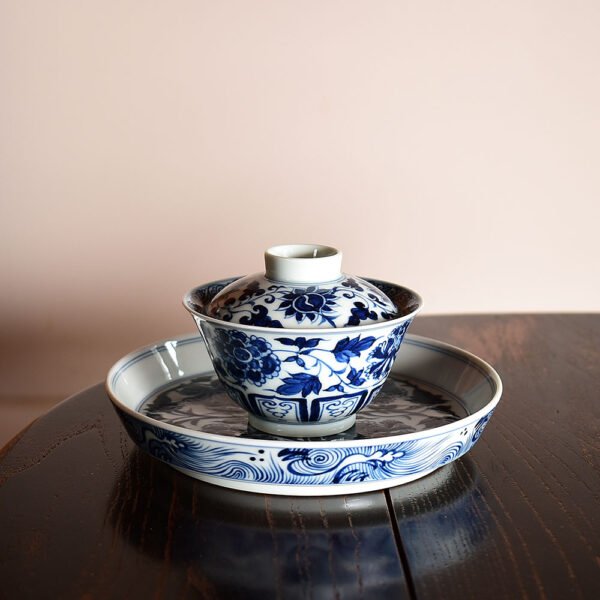
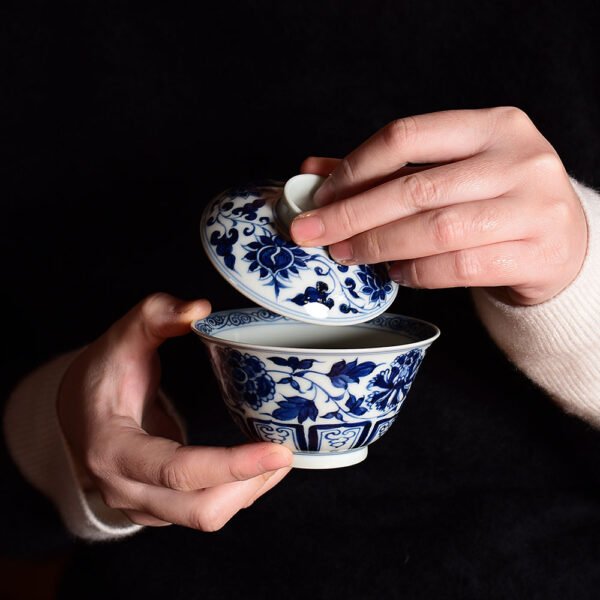 From: $989.98
From: $989.98The style of this super beautiful Gaiwan is Ming, using the underglaze blue technique, and entirely handcrafted and hand painted. The pattern features the classic design of intertwining Peony branches.
Peony, one of the beloved traditional patterns in our country, holds a special place in the hearts of the Chinese people with its lush and vibrant appearance and striking colors. As a symbol of our national spirit, it embodies the beautiful aspirations and good wishes for life, symbolizing the prosperity and longevity of the Chinese nation, with a history that stretches far into the past. The intertwined peony, known as “Wanshou Teng” or “Peony with Entwined Branches,” is a traditional auspicious pattern, that represents joyous occasions. Its continuous interlocking structure also conveys the meaning of “endless vitality” or “continuous growth.”
In addition, the beautiful tin spots on the porcelain add even more unique charm to it. The formation of tin spots is due to the high content of iron elements in local parts of the blue pigment. After reaching saturation in the high-temperature glaze solution and cooling down, the iron elements in the supersaturated part start to precipitate. If the iron content of the blue pigment is higher and the cooling rate is appropriate, tin spots are more likely to appear on the surface of the ware.
In addition to firing and materials, the formation of tin spots also involves the factor of glaze material. During the painting process, tin spots can also be formed due to the accumulation of blue pigment. Tin spots are more likely to appear on the surface of the ware at the intersections and the starting and ending points of brushstrokes. The formation of tin spots can be said to be a natural creation or an artificial decoration. This tin glazes not only add a rustic texture to the Gaiwan but also imbue it with a unique sense of history.
This Gaiwan exudes a charming style reminiscent of imitating the essence of Yuan Dynasty tea sets.
This tea set includes:
-
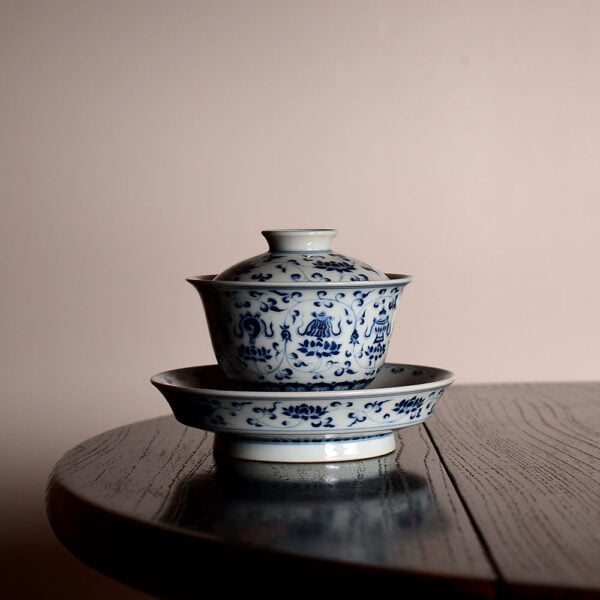
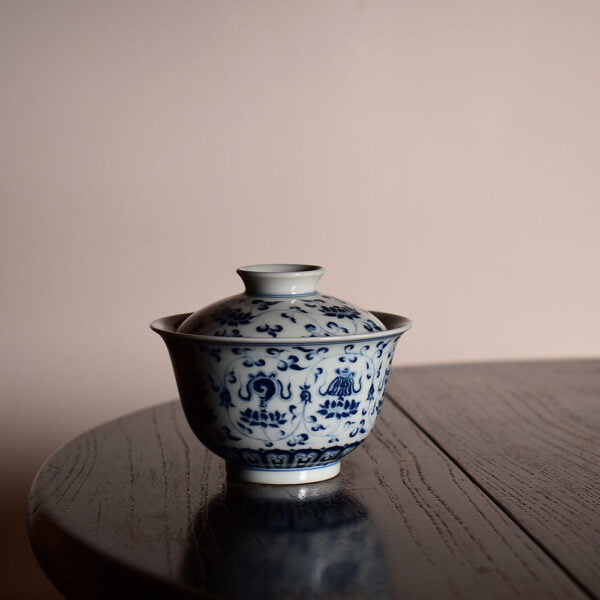 From: $1,695.98
From: $1,695.98The style of this super beautiful tea set is Ming, using the underglaze blue technique, and entirely handcrafted and hand painted. The pattern features very traditional Chinese patterns including intertwining lotus and ‘Ba Bao’.
The “Ba Bao,” also known as the “Buddhist Eight Treasures” or “Eight Auspicious Treasures,” represent eight auspicious objects symbolizing the power of Buddhism. These symbols manifest through the perception of eight types of consciousness: eyes, ears, nose, tongue, body, mind, intellect, and consciousness. They are depicted in various patterns and motifs as decorations in Buddhist art.
During the Qing Dynasty, particularly during the reign of Emperor Qianlong, these eight auspicious symbols were transformed into three-dimensional display items. They were often placed together with ritual vessels in temples. The eight auspicious symbols are abbreviated as follows: Conch Shell, Dharma Wheel, Umbrella, Canopy, Lotus Flower, Vase, Fish, and Endless Knot.
According to Buddhist beliefs, each of the “Eight Auspicious Symbols” has specific symbolic meanings:
- Conch Shell: Represents the auspicious sound of the Dharma, spreading throughout the world as a symbol of good fortune.
- Dharma Wheel: Signifies the endless cycle of Buddhist teachings, symbolizing the continuity of life.
- Umbrella: Symbolizes protection and the ability to shield and safeguard all sentient beings.
- Canopy: Represents the protection of the world and purification of the universe, symbolizing liberation from poverty and illness.
- Lotus Flower: Symbolizes purity and divine birth, representing the rejection of contamination.
- Vase: Represents the perfection of wisdom and fulfillment, symbolizing the achievement of success.
- Fish: Symbolizes liveliness, health, and vitality, serving as a sign of good luck and warding off evil spirits.
- Endless Knot: Represents the interconnectedness and endless nature of all things, symbolizing longevity, and a hundred years of life.
The construction of these symbols focuses on using auspicious objects as the main decorative elements, with their forms often being symmetrical or balanced. Some are complemented by flowing ribbons, while others are placed on a lotus pedestal, creating a harmonious and coherent effect among the different auspicious treasures.
During the Tang and Song Dynasties, the Eight Auspicious Symbols were introduced to the central plains with the spread of Tibetan Buddhism. By the Yuan Dynasty, they began to appear on silk, ceramics, gold, and silver items. In the Ming and Qing Dynasties, the application of the Eight Auspicious Symbols became even more widespread, involving lacquerware, furniture, architectural decorations, and other areas of craftsmanship.
The delicate brushstrokes and intricate detailing of the painting on this tea set create a distinct sense of aesthetic appeal. The soft and elegant shade of underglaze blue, along with a hint of faint tin glaze, gives it a graceful and ethereal beauty under the light. This tea set exudes a simple yet elegant charm, reminiscent of the style of imitation Ming, making it truly captivating and irresistible.
This tea set includes:
-

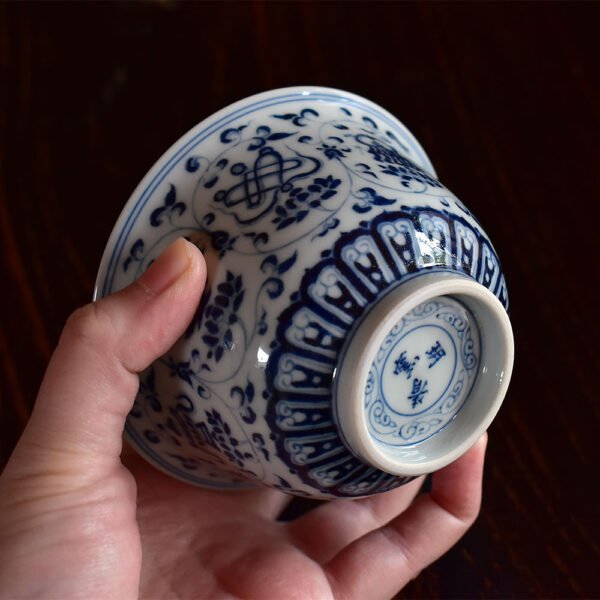 $749.99
$749.99The style of this super beautiful Gaiwan is Ming, using the underglaze blue technique, and entirely handcrafted and hand painted. The pattern features very traditional Chinese patterns including intertwining lotus and ‘Ba Bao’.
The “Ba Bao,” also known as the “Buddhist Eight Treasures” or “Eight Auspicious Treasures,” represent eight auspicious objects symbolizing the power of Buddhism. These symbols manifest through the perception of eight types of consciousness: eyes, ears, nose, tongue, body, mind, intellect, and consciousness. They are depicted in various patterns and motifs as decorations in Buddhist art.
During the Qing Dynasty, particularly during the reign of Emperor Qianlong, these eight auspicious symbols were transformed into three-dimensional display items. They were often placed together with ritual vessels in temples. The eight auspicious symbols are abbreviated as follows: Conch Shell, Dharma Wheel, Umbrella, Canopy, Lotus Flower, Vase, Fish, and Endless Knot.
According to Buddhist beliefs, each of the “Eight Auspicious Symbols” has specific symbolic meanings:
- Conch Shell: Represents the auspicious sound of the Dharma, spreading throughout the world as a symbol of good fortune.
- Dharma Wheel: Signifies the endless cycle of Buddhist teachings, symbolizing the continuity of life.
- Umbrella: Symbolizes protection and the ability to shield and safeguard all sentient beings.
- Canopy: Represents the protection of the world and purification of the universe, symbolizing liberation from poverty and illness.
- Lotus Flower: Symbolizes purity and divine birth, representing the rejection of contamination.
- Vase: Represents the perfection of wisdom and fulfillment, symbolizing the achievement of success.
- Fish: Symbolizes liveliness, health, and vitality, serving as a sign of good luck and warding off evil spirits.
- Endless Knot: Represents the interconnectedness and endless nature of all things, symbolizing longevity, and a hundred years of life.
The construction of these symbols focuses on using auspicious objects as the main decorative elements, with their forms often being symmetrical or balanced. Some are complemented by flowing ribbons, while others are placed on a lotus pedestal, creating a harmonious and coherent effect among the different auspicious treasures.
During the Tang and Song Dynasties, the Eight Auspicious Symbols were introduced to the central plains with the spread of Tibetan Buddhism. By the Yuan Dynasty, they began to appear on silk, ceramics, gold, and silver items. In the Ming and Qing Dynasties, the application of the Eight Auspicious Symbols became even more widespread, involving lacquerware, furniture, architectural decorations, and other areas of craftsmanship.
The delicate brushstrokes and intricate detailing of the painting on this Gaiwan create a distinct sense of aesthetic appeal. The soft and elegant shade of underglaze blue, along with a hint of faint tin glaze, gives it a graceful and ethereal beauty under the light. This Gaiwan exudes a simple yet elegant charm, reminiscent of the style of imitation Ming, making it truly captivating and irresistible.
-
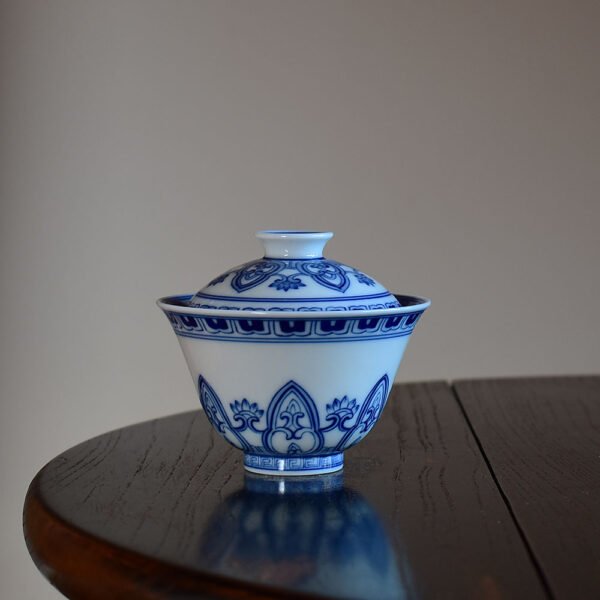
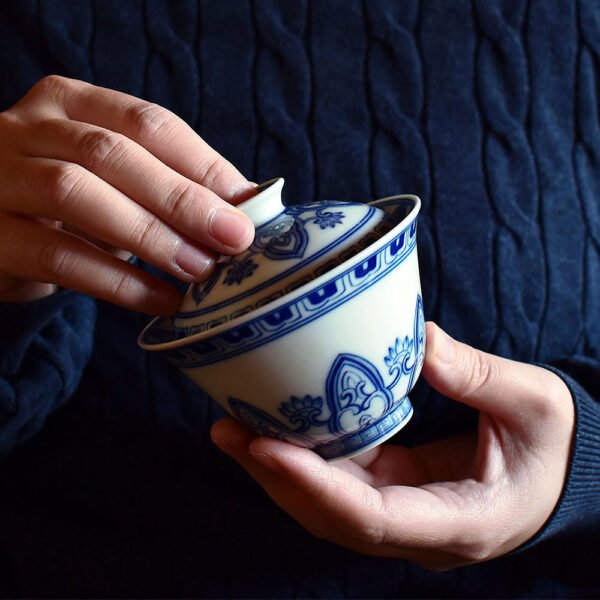 $259.99
$259.99This Gaiwan is completely handmade and hand-painted. The pattern featured is called “Bao Xiang” in Chinese, which is a traditional decorative motif representing one of the auspicious three treasures (Bao Xiang flower, Money tree, and Treasure basin), prevalent during the Sui and Tang dynasties in China. Bao Xiang pattern is also known as ‘Bao Xian Hua’ or ‘Bao Lian Hua’. Its lines are clear, and the colour is serene and antique. The Bao Xiang pattern design of this teaware is neat, and complex but not messy, and the whole picture of it is full and rich in details.
In Chinese culture, the Bao Xiang pattern symbolizes auspiciousness and happiness, representing people’s aspirations for happiness. It is widely popular in the decoration of silk brocade, bronze mirrors, and porcelain, showcasing people’s pursuit of a better life.
This Gaiwan features smooth and concise curves, combining the unique beauty of the Bao Xiang pattern, creating a visually appealing and enjoyable tea-drinking experience.
-
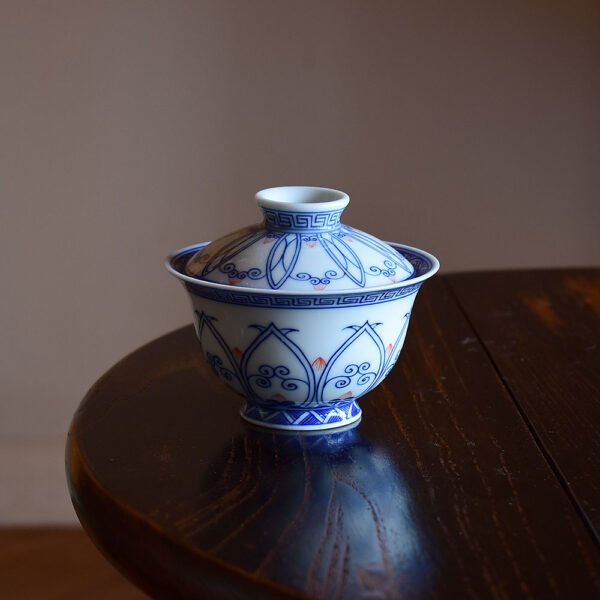
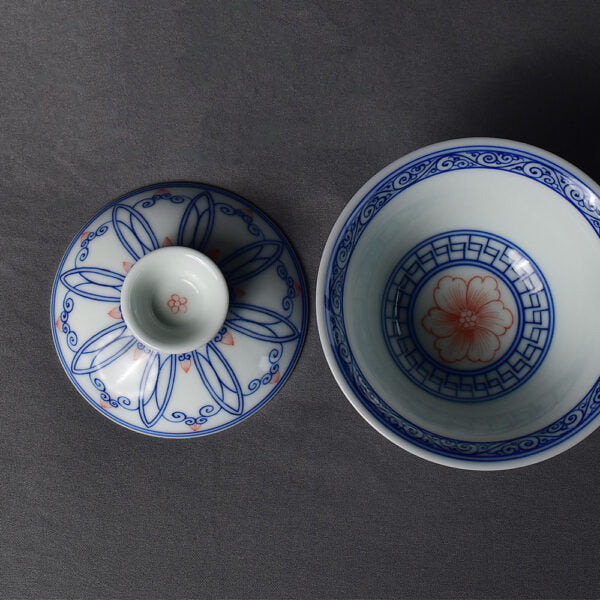 $259.99
$259.99This Gaiwan is completely handmade and hand-painted. The special craft used in this teaware includes Blue and white underglaze colour and underglaze red.
The pattern featured is called “Bao Xiang” in Chinese, which is a traditional decorative motif representing one of the auspicious three treasures (Bao Xiang flower, Money tree, and Treasure basin), prevalent during the Sui and Tang dynasties in China. Bao Xiang pattern is also known as ‘Bao Xian Hua’ or ‘Bao Lian Hua’. Its lines are clear, and the colour is serene and antique. The Bao Xiang pattern design of this teaware is neat, and complex but not messy, and the whole picture of it is full and rich in details.
In Chinese culture, the Bao Xiang pattern symbolizes auspiciousness and happiness, representing people’s aspirations for happiness. It is widely popular in the decoration of silk brocade, bronze mirrors, and porcelain, showcasing people’s pursuit of a better life.
This Gaiwan features smooth and concise curves, combining the unique beauty of the Bao Xiang pattern, creating a visually appealing and enjoyable tea-drinking experience. The blue and red underglaze colours complement each other and create a beautiful radiance.
-
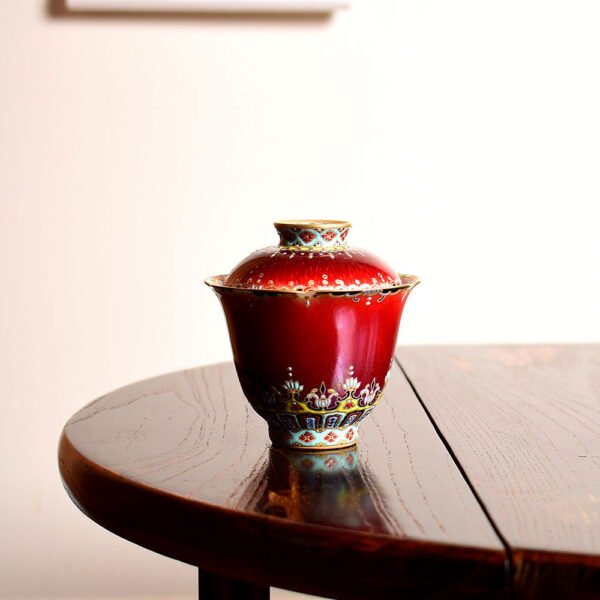
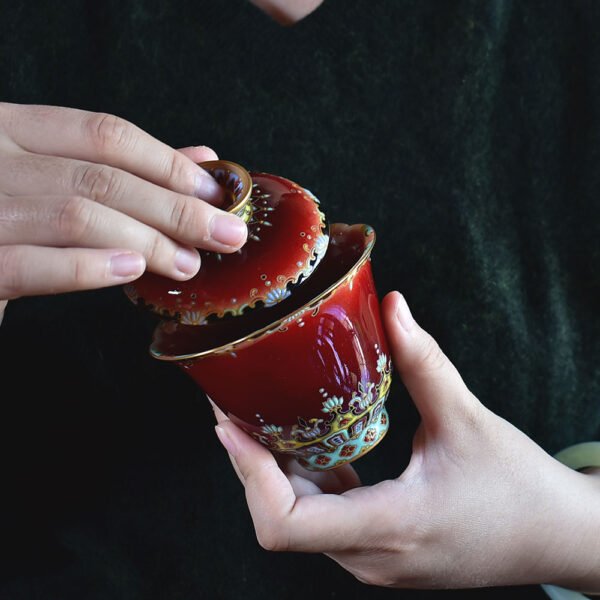 $849.99[vc_row et_row_padding="true" el_class="p-variations"][vc_column width="1/3" offset="vc_col-xs-4"][et_image alignment="aligncenter" image="30470" img_link="url:/p/hand-painted-lang-hong-enamel-dunhuang-gaiwan-san-cai/"][/et_image][/vc_column][vc_column width="1/3" offset="vc_col-xs-4"][et_image alignment="aligncenter" image="30531" extra_class="p-current"][/et_image][/vc_column][vc_column width="1/3" offset="vc_col-xs-4"][/vc_column][/vc_row]
$849.99[vc_row et_row_padding="true" el_class="p-variations"][vc_column width="1/3" offset="vc_col-xs-4"][et_image alignment="aligncenter" image="30470" img_link="url:/p/hand-painted-lang-hong-enamel-dunhuang-gaiwan-san-cai/"][/et_image][/vc_column][vc_column width="1/3" offset="vc_col-xs-4"][et_image alignment="aligncenter" image="30531" extra_class="p-current"][/et_image][/vc_column][vc_column width="1/3" offset="vc_col-xs-4"][/vc_column][/vc_row]This Ercai Gaiwan is handcrafted using the technique of gold painting, Lang Hong colouring and enamel glazed paint. The pattern on its painting is Dunhuang-style, with vibrant and luxurious colours, exuding a sense of luxury and elegance.
Gold painting, one of the decorative techniques, involves applying gold powder (gold dust) or bright gold (gold solution) on the porcelain surface to create intricate patterns or to complement other decorations such as borders or a golden background. Afterwards, the Gaiwan is fired at a low temperature to achieve the final finish. The lid, rim, and base of this Ercai Gaiwan are all embellished with intricate gold outlining craftsmanship.
The patterns on this Gaiwan depict Dunhuang-style designs, layered and intricate, displaying a rich array of colours. Among them, the lotus pattern is the most used decorative motif in Dunhuang art. From the Northern Liang to the Yuan Dynasty, lotus flowers can be found in every cave of the Mogao Grottoes. In Buddhism, the lotus symbolizes purity and enlightenment. It is believed that one’s soul can attain rebirth through the lotus, leading to the blissful Western Pure Land. Within the Mogao Grottoes, lotus flowers adorn the background, embellishing figures of bodhisattvas and celestial beings, embodying the sacred and immaculate nature of Buddhas and bodhisattvas. Hence, the lotus is the quintessential flower representing Buddhism. Apart from the lotus, another significant motif is the honeysuckle, also known as Jin Hua (golden-silver flower). It is an important decorative symbol in Dunhuang art, introduced alongside Buddhist art in China as a decorative floral theme. The rise of honeysuckle patterns in China occurred nearly simultaneously with the spread of Buddhism. Its extensive use in Buddhist decorations during the Northern Dynasties influenced secular ornamentation at that time. Honeysuckle blooms during summer, transitioning from white to yellow after budding, shedding old leaves in late autumn, and promptly producing new leaves. It endures even in the harshest winter conditions, quietly thriving in the wild with minimal requirements of water and soil. As a result, the honeysuckle pattern found abundant application in Buddhist-related decorations, drawing from its persistent growth characteristics. Furthermore, the motif of the “Baoxiang Flower,” also known as Baoxianhua or Baolianhua, is another traditional auspicious pattern in Dunhuang decorations. It is one of the auspicious Three Treasures and was prevalent during China’s Sui and Tang Dynasties. The concept of “Baoxiang” originates from Buddhism, where it refers to a respectful term for Buddhist images. The Baoxiang Flower represents an idealized form of purity, grace, and beauty.
In addition to these captivating decorative patterns, the craftsmanship of Lang Hong ceramics is also deserving of praise. Firstly, the full name of Lang Hong is “Langyao Red,” also known as “Gem Red” or “Ox Blood Red.” It is one of the most vibrant colours in traditional Chinese precious copper red glazes. Lang Hong glaze is achieved by using copper as a colouring agent and firing it at a high temperature of 1300°C. Since copper elements easily evaporate at high temperatures, the range of colour expression is limited. The firing process demands strict control over the atmosphere and temperature, and the outcome is greatly affected by external factors, making it a highly challenging process to successfully produce Lang Hong ceramics. Lang Hong glaze boasts a smooth and translucent surface, resembling glass, with crackled patterns resembling cow hair texture. The glaze exhibits a deep and vivid colour, resembling freshly congealed ox blood with its brilliant crimson hue, symbolizing auspiciousness, and wealth. Revered as a “treasure among a thousand kilns,” the red-glazed porcelain of Lang Hong showcases a distinctive ethnic style, shining like a dazzling gem in the history of world ceramics. The colour red, known for its auspiciousness and affluence, has elevated Lang Hong ceramics to a radiant and remarkable masterpiece in the realm of ceramic art.
Enamel, on the other hand, is a decorative technique that involves transplanting the cloisonné enamel method onto a porcelain body as an overglaze colour decoration. Enamel decoration on porcelain, known as “Fàlángcǎi” in Chinese, entails painting colourful patterns on the porcelain surface and then firing it at high temperatures to fuse the colours with the porcelain, achieving a durable and splendid design. These patterns often feature exquisite themes such as flowers, birds, figures, and landscapes, reflecting the essence of traditional Chinese culture and art. The process of creating enamel decorations is extremely intricate and complex, requiring skilled and experienced craftsmen. First, the porcelain prototype is made, and then special mineral pigments are used to paint patterns on its surface. Once the painting is completed, a series of firing processes follow, during which the temperature and timing for both the porcelain and the enamel colours are crucial factors. Improper temperature or timing can result in cracks in the porcelain or unstable colours. Enamel decoration is considered a treasure in traditional Chinese craftsmanship, representing the wisdom and skills of ancient Chinese artisans.
This Gaiwan showcases exquisite Lang Hong craftsmanship, with intricate and delicate Dunhuang patterns that carry profound symbolism.
-
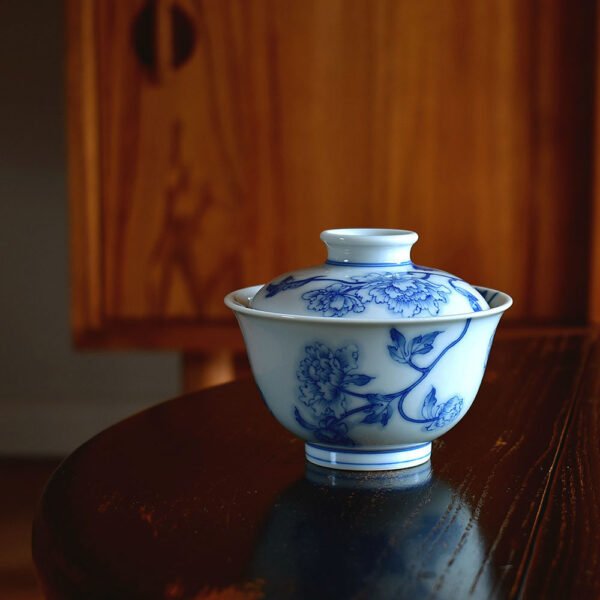
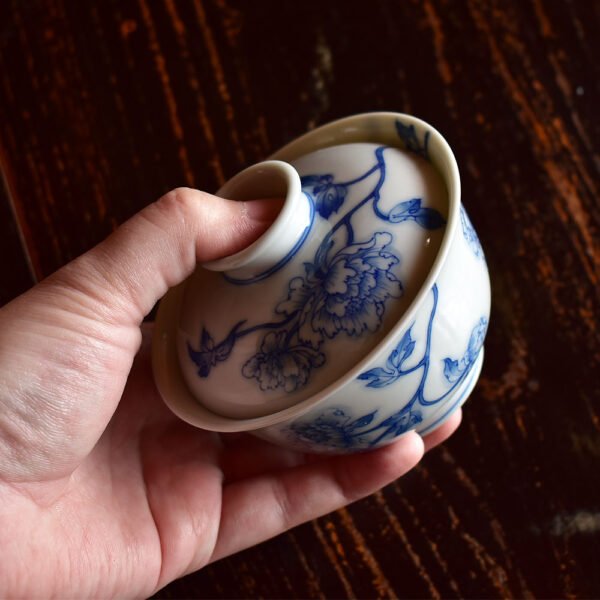 $289.99
$289.99This set is entirely handmade and hand-painted. The pattern features blooming peonies, which are one of the symbols in traditional Chinese culture, representing wealth, happiness, and prosperity, which makes it commonly used in various aspects of life in ancient China.
The entire shape of it is smooth and lustrous, while the painting is vivid and ethereal. The exquisite blue and white peonies provide you with a unique visual enjoyment while you enjoy your tea.
-
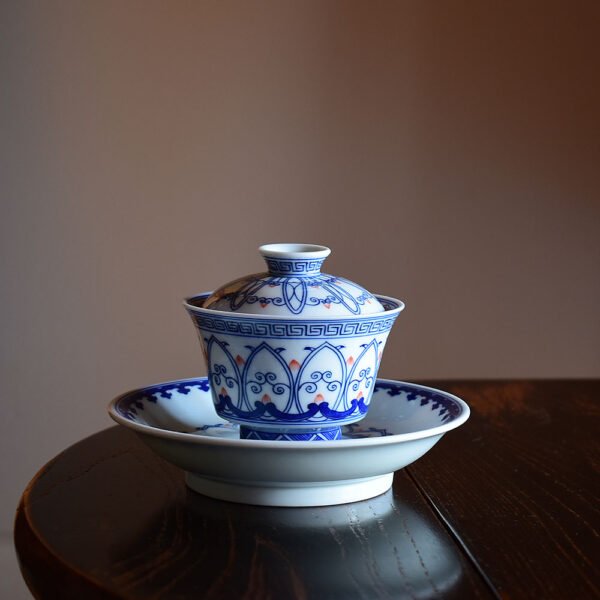
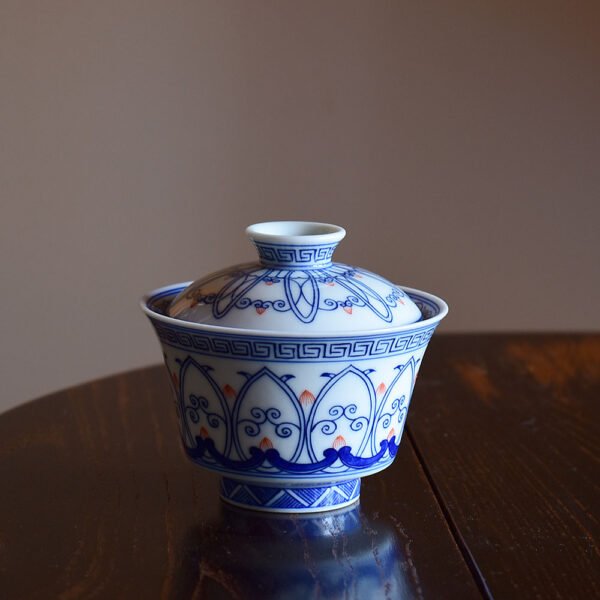 From: $455.98
From: $455.98This tea set is completely handmade and hand-painted. The special craft used in this teaware includes Blue and white underglaze colour and underglaze red. The special horseshoe-shaped design allows for easy handling and prevents becoming too hot to touch.
The pattern featured is called “Bao Xiang” in Chinese, which is a traditional decorative motif representing one of the auspicious three treasures (Bao Xiang flower, Money tree, and Treasure basin), prevalent during the Sui and Tang dynasties in China. Bao Xiang pattern is also known as ‘Bao Xian Hua’ or ‘Bao Lian Hua’. Its lines are clear, and the colour is serene and antique. The Bao Xiang pattern design of this teaware is neat, and complex but not messy, and the whole picture of it is full and rich in details.
In Chinese culture, the Bao Xiang pattern symbolizes auspiciousness and happiness, representing people’s aspirations for happiness. It is widely popular in the decoration of silk brocade, bronze mirrors, and porcelain, showcasing people’s pursuit of a better life.
This tea set includes:
-
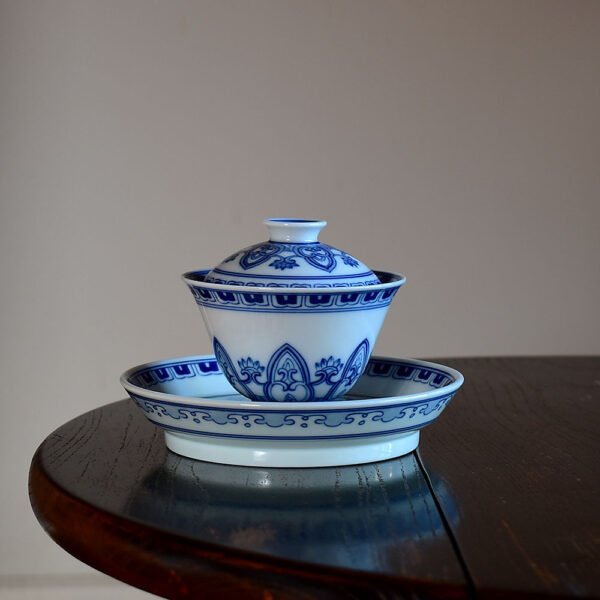
 From: $455.98
From: $455.98This tea set is completely handmade and hand-painted. The pattern featured is called “Bao Xiang” in Chinese, which is a traditional decorative motif representing one of the auspicious three treasures (Bao Xiang flower, Money tree, and Treasure basin), prevalent during the Sui and Tang dynasties in China. Bao Xiang pattern is also known as ‘Bao Xian Hua’ or ‘Bao Lian Hua’. Its lines are clear, and the colour is serene and antique. The Bao Xiang pattern design of this teaware is neat, and complex but not messy, and the whole picture of it is full and rich in details.
In Chinese culture, the Bao Xiang pattern symbolizes auspiciousness and happiness, representing people’s aspirations for happiness. It is widely popular in the decoration of silk brocade, bronze mirrors, and porcelain, showcasing people’s pursuit of a better life.
This tea set features smooth and concise curves, combining the unique beauty of the Bao Xiang pattern, creating a visually appealing and enjoyable tea-drinking experience.
This tea set includes:
-
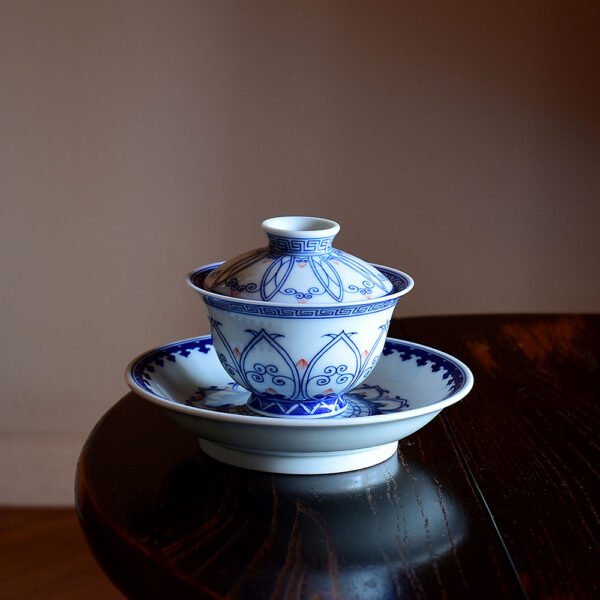
 From: $489.98
From: $489.98This tea set is completely handmade and hand-painted. The special craft used in this teaware includes Blue and white underglaze colour and underglaze red.
The pattern featured is called “Bao Xiang” in Chinese, which is a traditional decorative motif representing one of the auspicious three treasures (Bao Xiang flower, Money tree, and Treasure basin), prevalent during the Sui and Tang dynasties in China. Bao Xiang pattern is also known as ‘Bao Xian Hua’ or ‘Bao Lian Hua’. Its lines are clear, and the colour is serene and antique. The Bao Xiang pattern design of this teaware is neat, and complex but not messy, and the whole picture of it is full and rich in details.
In Chinese culture, the Bao Xiang pattern symbolizes auspiciousness and happiness, representing people’s aspirations for happiness. It is widely popular in the decoration of silk brocade, bronze mirrors, and porcelain, showcasing people’s pursuit of a better life.
This tea set features smooth and concise curves, combining the unique beauty of the Bao Xiang pattern, creating a visually appealing and enjoyable tea-drinking experience. The blue and red underglaze colours complement each other and create a beautiful radiance.
This tea set includes:





